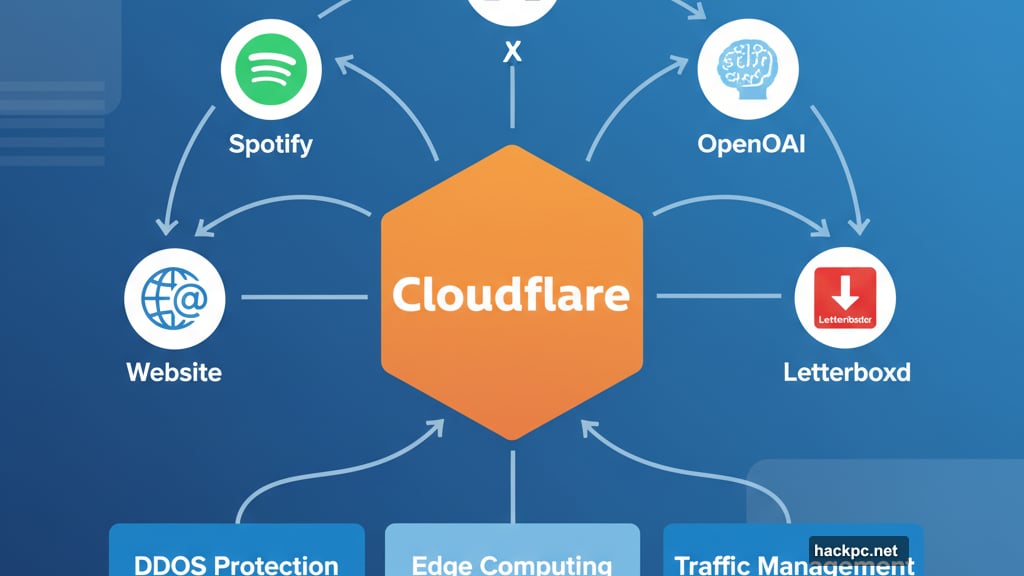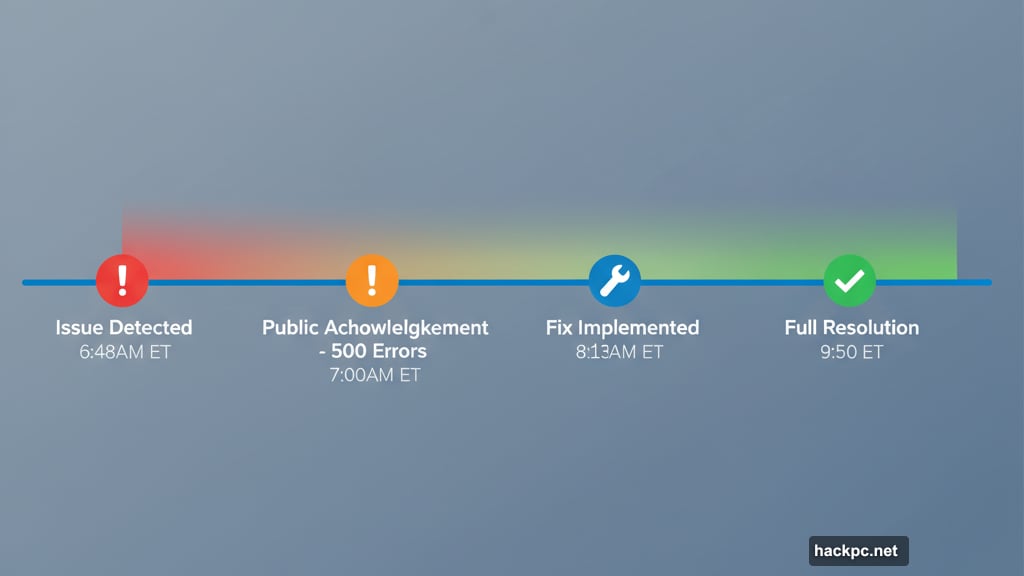The internet stopped working this morning for millions of users. Not a cyberattack. Not a cable cut. Just Cloudflare having a really bad day.
If you couldn’t access X, Spotify, or basically any major website around 7AM ET, you experienced what happens when critical internet infrastructure fails. And boy, did it fail spectacularly.
What Actually Broke
Cloudflare powers a massive chunk of the internet. The company provides security, speed optimization, and protection against cyberattacks for millions of websites. When it goes down, the ripple effects are instant and widespread.
This morning’s outage hit hard. Users saw “internal server error” messages across countless sites. Even Downdetector, the site you’d normally check to see what’s broken, went down. That’s peak irony.
The company acknowledged the problem around 7AM ET. Their status update was brief: “Cloudflare is aware of, and investigating an issue which potentially impacts multiple customers.”
Translation? We broke stuff. Lots of stuff. We’re scrambling to fix it.
Why This Matters More Than You Think
Cloudflare isn’t just another tech company. It’s infrastructure that makes the modern internet function. Think of it as the power grid for websites.
The company handles edge computing, DDoS protection, and traffic management for ISPs and Fortune 500 businesses. When Cloudflare hiccups, major sites go dark instantly.
Plus, Cloudflare serves as a critical defense layer. Many sites rely on it to stay online during cyberattacks or traffic surges. So when it fails, those sites lose both performance and protection simultaneously.
This morning proved how fragile our internet infrastructure really is. One company has an internal issue, and suddenly X, OpenAI, Spotify, and Letterboxd all vanish. That’s a lot of eggs in one basket.
The Timeline of Chaos
The outage started around 6:48AM ET when Cloudflare’s internal monitoring detected issues. By 7AM, the company publicly acknowledged widespread 500 errors affecting its dashboard and API.

Users worldwide reported connection failures. Social media exploded with complaints (on platforms that still worked, anyway). IT departments scrambled to understand if their systems were the problem.
Around 8:13AM ET, Cloudflare announced they’d identified the issue and were implementing fixes. Their Access and WARP services recovered first, returning to normal error rates.
By 9:42AM ET, the company declared victory. “We believe the incident is now resolved,” they wrote. Though some sites, including X, continued showing errors for multiple users even after that announcement.
Finally, at 9:50AM ET, Cloudflare confirmed full resolution. The internet exhaled collectively.
What Cloudflare’s CTO Said
Dane Knecht, Cloudflare’s CTO, didn’t sugarcoat it. He posted a blunt apology on X (when it came back online).
“I won’t mince words: earlier today we failed our customers and the broader Internet when a problem in the Cloudflare network impacted large amounts of traffic that rely on us,” he wrote.
He added that affected sites, businesses, and organizations depend on Cloudflare’s availability. His apology acknowledged the real impact this caused. No corporate spin. Just straight admission of failure.
Knecht also clarified this wasn’t a cyberattack. The failure came from internal issues, not external threats. That’s almost worse. It means Cloudflare broke itself.
He promised a detailed post-mortem later today explaining what went wrong. That analysis will be crucial. Other companies need to understand the failure mode to prepare for similar incidents.
The Bigger Infrastructure Problem
This outage exposes a fundamental vulnerability in how we’ve built the internet. Massive consolidation creates single points of failure.
Cloudflare, AWS, Google Cloud, and a handful of other companies now control vast portions of internet infrastructure. When one fails, huge swaths of the web go dark. There’s no redundancy at that level.

Moreover, many companies don’t realize how dependent they are on these providers. Your website might not directly use Cloudflare. But your CDN might. Or your DNS provider. Or your security layer. The dependencies stack up invisibly.
This morning demonstrated the risk. Millions of users couldn’t access critical services for hours. Businesses lost revenue. Communications broke down. All because one infrastructure provider had internal problems.
The internet was designed to route around failures. But we’ve rebuilt it with centralized choke points that defeat that original resilience.
What You Can Do (Not Much)
Individual users can’t do much when infrastructure providers fail. That’s the harsh reality.
You could switch to different services that don’t rely on Cloudflare. But good luck finding them. The company’s reach is enormous. Plus, any alternative probably depends on similarly centralized infrastructure.
For businesses, the options are slightly better but still limited. You can implement multi-provider strategies. Use different CDNs for different regions. Maintain fallback systems that bypass Cloudflare entirely.
But those solutions cost money and add complexity. Small companies especially struggle to afford proper redundancy. So they gamble that their infrastructure providers won’t fail.
This morning, that gamble didn’t pay off.
The Internet Needs Better Architecture
Today’s outage should spark serious conversations about internet infrastructure. We’ve traded resilience for convenience and efficiency. That tradeoff looked smart until it didn’t.
The original internet was designed to survive nuclear war. No single point of failure. Traffic would route around damage automatically. We’ve abandoned that vision for centralized platforms that offer better performance and security.
Maybe we need to find a middle ground. Keep the benefits of modern infrastructure providers while building genuine redundancy and failover capabilities. That won’t happen quickly or cheaply. But this morning showed the cost of not doing it.
The internet recovered this time. Cloudflare fixed their internal problems. Services came back online. Users moved on with their day. But the fundamental vulnerability remains. Next time, we might not get lucky so fast.
Post Title: Cloudflare Outage Broke Internet: What Went Wrong
Meta Description: The internet stopped working this morning for millions of users. Not a cyberattack. Not a cable cut. Just [Cloudflare](https://www.cloudflare.com) having a really bad day.



Comments (0)